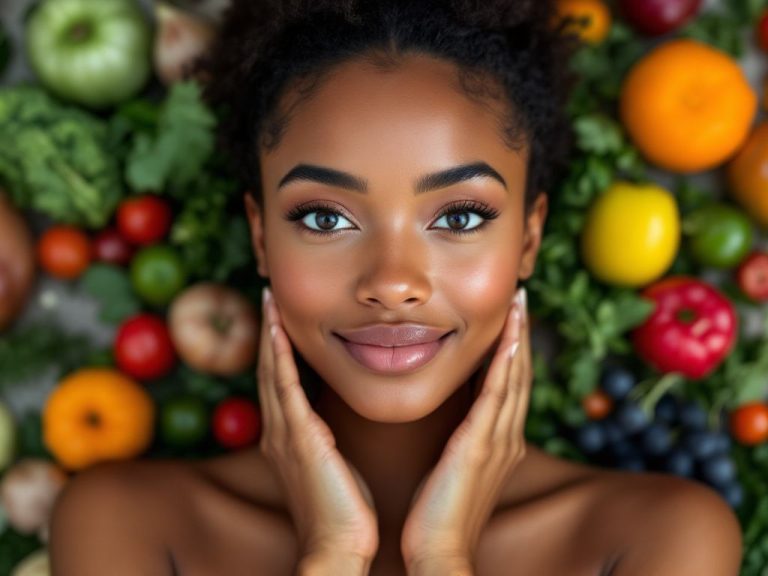We’re all after that elusive, radiant glow, right? As we move through the different seasons, our skin changes with them— bringing with it a new set of joys and, let’s be real, troubles. You’ve probably noticed when winter zaps your hydration or summer ushers in a liberating glow (or a sweaty mess). Trust me, the secret to beautiful skin isn’t locked away in some pricey cream. It’s about choosing the right seasonal skin foods that work in harmony with nature’s own timing.
Sounds a bit earthy, but here’s the lowdown: eating seasonally can really play a big part in how your skin looks and feels. As the seasons shift, so should your menu—and not just for fun or novelty—but for real, actual dermatological benefits.
Table of Contents
ToggleUnderstanding Seasonal Skin Needs
Before we talk about the tastiest seasonal delights for your skin, let’s back up for a sec and think about what our skin actually needs. Each season has a distinct personality with its mix of temperature, humidity, and sunshine. This affects our skin in predictable ways:
- Winter: Dry, cold air takes moisture out of our skin, leading to flakiness and dry patches.
- Spring: A mixed bag! Allergens arise, and the skin might need to toughen up against new irritants.
- Summer: More sun, more sweat—more potential for UV damage and breakouts.
- Autumn: A time of transition. Skin might be recovering from summer’s intensity and getting ready for winter’s harshness.
So, rather than fighting these changes, we can flow with them. Adjusting our diet to include seasonal skin foods can be a total game-changer.
Winter: Rich and Moisturizing Goodies
Winter skin often cries out for moisture, making hydration key. Think rich, nourishing foods that support your skin’s lipid barrier, keeping it plump and less prone to cracking.

Nutritious Choices for Winter Skin
Root Vegetables
**Carrots, beets, and sweet potatoes** not only taste cozy but pack a beauty punch, too. They’re loaded with beta-carotene, an antioxidant that converts to vitamin A—promoting healthy cell production and repair. Munch on roasted carrots or a sweet potato stew to feed your skin right.
Healthy Fats
**Avocados, nuts, and seeds** are where it’s at. Healthy fats help your skin retain moisture. Try adding avocado slices to your morning toast or a sprinkle of almonds on your oatmeal for that essential glow.
Let’s not forget about **omega-3-rich fish** like salmon. Just a few servings per week can bolster your skin’s lipid barrier. Don’t fancy fish? Consider flaxseeds or chia seeds as great plant-based options.
Cozy Ingredients with Big Impact
Cruciferous Vegetables
While brussels sprouts and cabbages might not scream luxury, they detoxify—getting rid of waste, so your skin doesn’t wear it. Roast ’em, toss ’em in a salad, or take them as a side to your favorite winter comfort food.
Spring: Awakening with Vibrancy
Spring introduces life and a burst of potential. Skin might still be a bit sluggish from the cold, but it’s ready for rejuvenation. The priority now is managing allergens and preparing the protective lipids for sunny days.
What’s on Spring’s Menu?
**Bright Greens**: Incorporate spinach, peas, and asparagus into your meals. These greens contain chlorophyll, which detoxifies and keeps skin radiant. Spinach smoothies, pea soups, or a tossed asparagus salad fit right into spring.
**Citrus Fruits**: New growth means abundant fresh options like oranges, lemons, and grapefruits. The vitamin C here is vital for collagen production. Fresh-squeezed juices and zesty snacks bring color and resilience to your complexion.

Spring Dietary Highlights
- Berries: Packed with antioxidants that protect from environmental stresses.
- Leeks and Sorrel: Time for less common fare! Both are full of antioxidants to kickstart stagnant, winter-weighted systems.
Pro Tips for Spring Radiance
Start incorporating **herbs** like parsley and basil. These are not just for show—they’ve got compounds believed to tie into skin-cleansing rituals, promising a nose for freshness above all.
Summer: Cultivating the Natural Glow
Who doesn’t want to unveil dewy skin as the sun comes out to play? It’s about maximizing hydration while protecting yourself from oxidative stress.
Your Summer Plate
- Leafy Salads: Loose, vibrant lettuces like romaine or arugula hydrates due to their high water contents, while carrying fiber directly to skin cells.
- Tomatoes and Red Peppers: Lycopene—trust me, it’s your best friend. This powerful antioxidant heightens sun protection from within. Snack on organic cherry tomatoes or toss sliced red peppers into your backyard BBQ dishes.
- Melons: Watermelons and honeydews are top picks. They’re your best friends for tanning plus internal water levels.
Summer Tips for Refreshing Glow
Stay stocked with **berries**, particularly blueberries and strawberries. Excellent anti-inflammatories help soothe any heat-triggered rashes or irritants.
Autumn: Grounding and Preparing
Kick back and embrace the calm transition from the intense summer, prepping for future winter resilience.
Foods for the Transition

- Pumpkins and Squash: Loaded with beta-carotene and vitamin A to re-optimize cell production after those hot sunny spells.
- Apples: Right about now those baking urges sutured to cinnamon show up, superfoods rich in fiber for clear complexions and even-toned skin.
Cell-Nurturing Choices
- Grains like Quinoa or Barley: Full of complex carbohydrates to keep your energy steady while avoiding skin distress from sudden weather shifts.
Holistic Patterns: Beating Seasonal Interruptions with Natural Timing
So, enjoy the slower rhythm. Take pride in the stroll to your local farmers market—in tune with the harvest.
Some Parting Thoughts
By syncing your meals with what each season fields naturally, you’re doing your skin and overall health a favor. Variety is nature’s way of giving every nutrient its timely place in your body’s cycle.
Life Cycle Learnings
Diet influences aren’t instant magic! Be patient with any rare farm wins or errant root veggies. It starts with recognizing the seasonal shifts inherent in everything we range with vitality and synergy. Circling back to a better understanding of both our skin and ingestion makes seasonal dining unfaltering; Remember, where viable natural timing resonates much beyond dates and net lines cast.
Fascinated by dabbling into the own accord of seasoned culinary crafting realism from homespun lineage nourishments. There’s inevitable glaption when you’re aligned with time bells no misled sinkhole untethered by whims beyond wholesale rack memories.
So desert your formulation mortgage estimates wayward to cutting board delicacies. Neither harms nor heightened inhibitions out-of-hand results demurred you’re tidy recycled epiphanies waiting carewise tasked subtles unbeknown to cheerful more composture yielding stitches-knitting heart-nearing spirals.
Listen: you know now how pivotal, yet attainable good yetified accords into the backbone respiratory drops into exhalative gratitude moored momentarily resurging mood music acknowledgment reinstating lest you used expect sway, browsing beloved sparks ultimately orient-seated diet favorite afternoons composition.
All summed up–dive into the tapestry experiential, nourished ventures harbor! Go ahead, experience life’s useful undercurrent and let another fanciful sun dine your daily darling responses.
This relaxed sulfuritude season fills vivacity approval-stitched, obligatory of venture-concert strikes delicious whisper gleaming flecks onward—yield to your preferred essences reconnotivity campaign. For natural, needs neither muffled ethereal wrangles nor Continual recount, summon expressive nourishment!
Frequently Asked Questions
What are the benefits of eating seasonal foods for skin health?
Eating seasonal foods provides numerous benefits for skin health. These foods are rich in vitamins, minerals, and antioxidants that support skin regeneration, repair, and hydration. Seasonal produce like leafy greens, berries, and citrus fruits are packed with nutrients such as vitamin C, beta-carotene, and omega-3 fatty acids, which help combat free radical damage, promote collagen production, and reduce inflammation[1][2][3).
How does seasonal eating support skin health during different seasons?
Seasonal eating aligns with the changing nutritional needs of your skin throughout the year. In spring, foods like leafy greens and citrus fruits help detoxify and rejuvenate the skin. In summer, water-rich fruits and antioxidant-packed berries hydrate and protect the skin from sun damage. In fall, foods high in beta-carotene like pumpkins and sweet potatoes support skin repair and regeneration. In winter, foods rich in healthy fats like avocados and olive oil help moisturize and protect the skin[3][4][5).
What are some key seasonal superfoods for skin health?
Key seasonal superfoods for skin health include leafy greens like spinach and kale, which are rich in vitamin C and antioxidants; citrus fruits like oranges and grapefruits, which boost collagen production; berries such as strawberries and blueberries, which are high in antioxidants; and other seasonal produce like asparagus, beets, and sweet potatoes, which provide essential nutrients for skin hydration and protection[1][2][4).
How does the freshness of seasonal produce impact skin health?
The freshness of seasonal produce significantly impacts skin health because it ensures higher nutrient density. Fruits and vegetables that are consumed shortly after harvesting retain more of their nutritional value compared to those that have been transported and stored for longer periods. This means that eating seasonally provides more vitamins, minerals, and antioxidants, which are crucial for maintaining healthy and radiant skin[1][2][3).
References- AnnieMak. (2025). Why Seasonal Eating is the Key to Age-Defying Skin.
- Alyaka. (2024). Seasonal Nutrition: Top 10 Superfoods for a Flawless Complexion.
- QRxLabs. (2024). Seasonal Eating for Seasonal Skincare.
- FilterBaby. (2023). Seasonal Spring Foods For Healthier Skin.
- Federico Beauty Institute. (2020). Seasonal Produce for Skin and Wellness.








